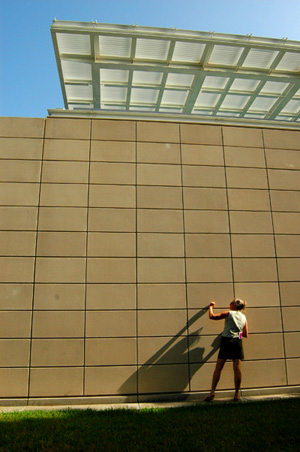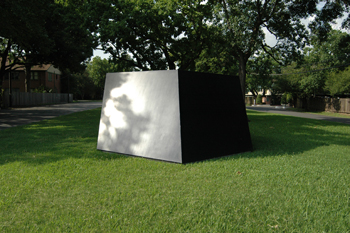Speaking to Art
Art Tourist visits the Neighborhood at the de Menil Collection

HOUSTON – Magritte after Magritte, Max Ernst after Max Ernst, the collection of Surrealists’ work at the de Menil Collection is astounding visit after visit. This museum devoted to the purchases of Dominique de Menil and family/foundation, is to Surrealism what the Musée d’Orsay is to Impressionism.
In addition, the de Menil has been building outlaying small museums around the main structure to house contemporary artists. The Cy Twombly gallery showed off the light of Texas in June in a way I had never seen it before. It filtered in through the ceiling of the building designed by architect Renzo Piano and changed as clouds moved overhead changing the color of the enormous Twombly painting custom made for the first gallery room, filling one wall with only inches to spare.
The attendant in this gallery was the reincarnation of Desi Arnez and charmed us with his tales of Mr. Twombly and his Italian socialite wife, the atmosphere was presidential library, yet clear and uncluttered, and the content vivid expressionist art of the Cy Twombly School. Elegance in space. Expression inside.
I’m not usually given to slogans but this hot day in Houston I was a push over for beautiful space and the shady museum grounds.

Crossing three blocks and finding a couple of Tony Smith sculptures outside a renovated retail building, we knew we’d come to the gallery where we’d see the work of Dan Flavin. Inside, art is immediate: big, long room with a three-color florescent lightwork shooting straight back along the vertical center of each wall, left and right of us, a horizon line receding into the long room describing distance like a landscape.
Behind this room was a stark contrast: a small square room with two openings for coming and going, but otherwise displaying all-white florescent bulbs in various configurations. In the center was a man in striped, green and lime-green pants. “Are you part of the art?” I asked. He asked back, ”who is speaking, and who is listening?” I took this as a philosophical questions and thought, for sure, he was part of the installation. I’d been reading Roland Barthes, a French philosopher, and Barthes had surprised me by thinking how one dressed was very important, that our appearance was the simplest expression, but he would be contemptuous of people who judge other people. I am judgmental about art, and maybe I liked this room more because it contained the man with a very elegant sense of color and style. Beyond that, we started talking about art.
He said experiential artworks made by artists like Flavin need physical spaces where their art can be shown permanently, like the Chinati Foundation in Marfa, Texas, for Donald Judd. He made me think that making installation art or environmental work was more like cooking than art unless you could create a specific place for it. The simple example was just blocks away at the Rothko Chapel in Houston. Seeing one painting by Mark Rothko is a snapshot, seeing Rothko paintings arranged as the artists specified, as in the chapel or the new installation at the new Tate in Britain, is seeing the whole movie. More ethereal work like Flavin’s fluorescent light, or James Turrell’s natural light, or Ann Hamilton’s line drawn around a room, need to be situated somewhere if people are going to be able to experience them, see them, in the future.
Turns out, this man was Heiner Friedrich, the founder of the Dia Foundation, who helped establish Marfa, Turrell’s Roden Crater, maintains Robert Smithson’s Spiral Jetty, and the space we were in. We didn’t know this at the time, and just liked him, so we asked if he wanted to join us for Mexican food a few blocks away.
Terry Talty writes about contemporary art in the persona of the Art Tourist, looking at art so you don't have to.